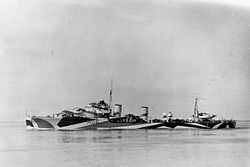HMS Hurricane (H06)
|
||||||||||||||||||||||||
|
||||||||||||||||||||||||
|
||||||||||||||||||||||||
|
||||||||||||||||||||||||
HMS Hurricane (H06) was an H-class destroyer of the British Royal Navy during World War II . The ship under construction for the Brazilian Navy was purchased by Great Britain immediately after the start of the war, along with its five sister ships.
The hurricane torpedoed by a wren on December 24, 1943 northeast of the Azores by U 415 was sunk on the 25th after the crew had been removed from the destroyer Watchman , as the severely damaged ship could not reach home on its own.
history
The ship was launched on September 29, 1939 as part of a class of six destroyers for the Brazilian Navy at Vickers-Armstrong in Barrow-in-Furness , Cumbria . On September 4, 1939, immediately after the start of the war, Great Britain had bought the destroyer, which was to be named Japarua , which was immediately renamed HMS Hurricane . It entered service on June 21, 1940.
The destroyer was together with his former Brazilian sister ships of the 9th destroyer flotilla assigned. Tactically, however, the ship was assigned exclusively to escort groups that escorted convoys .
The area of operation of the ship was in the North Atlantic for almost the entire war . HMS Hurricane served as the lead ship of one of the escort groups, which consisted of a few, mostly older destroyers and several corvettes . The anti -submarine and anti-aircraft armament was reinforced over time at the expense of the main guns and a torpedo tube set.
On September 18, 1940, the hurricane in the North Atlantic took 105 survivors of the City of Benares , a British passenger steamer that had been sunk by a German submarine.
During a German air raid on Liverpool on 7./8. May 1941 the ship lying in the harbor was badly damaged by a bomb and sank. The repair dragged on until January 1943.
Then the destroyer took part in the great convoy battles in the spring of 1943. From autumn 1943, the escort group led by HMS Hurricane was deployed on the convoy route between Great Britain and Gibraltar in addition to the North Atlantic route . Unlike many other escorts, the ship could not sink submarines during its mission .
On December 24, 1943, Hurricane was torpedoed northeast of the Azores from a Gibraltar escort by U 415 using an acoustic torpedo . The stern of the still floating ship was totally destroyed, but was unable to maneuver and without a drive. The frigate Glenarm took over the crew of the Hurricane and the destroyer Watchman sank the severely damaged ship, on which there had been three dead during the torpedoing, with a torpedo at 45 ° 10 ′ N , 22 ° 5 ′ W .
Individual evidence
literature
- Michael J. Whitley: Destroyers of World War Two. An international encyclopedia. Arms and Armor Press, London et al. 1988, ISBN 0-85368-910-5 .

